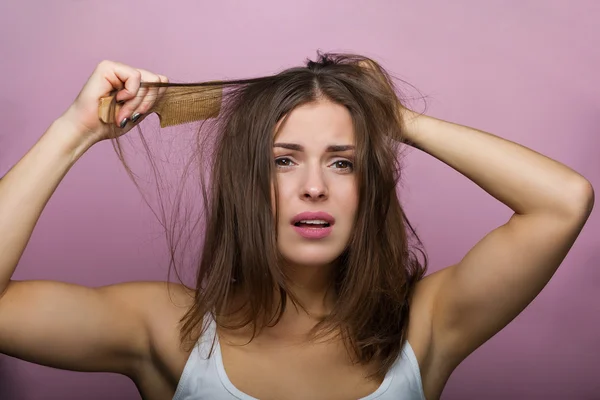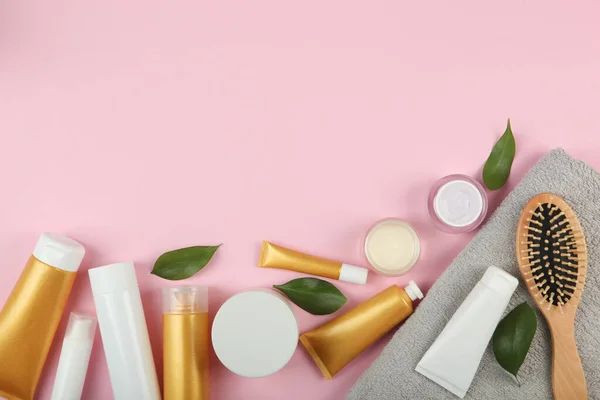Discover expert-backed tips and healthy hair products for damaged hair. Learn how to restore strength, shine, and structure with dermatologist-recommended solutions.
Table of Contents
Introduction
Hair damage is more than just split ends—it’s a structural issue. Whether it’s from heat styling, coloring, or environmental exposure, once your hair fibers are compromised, they require targeted care to restore their integrity. As a pharmacist and advocate for evidence-based wellness, I’ve compiled a practical, science-driven guide to help you choose the best healthy hair products for damaged hair.
Why Damaged Hair Needs Special Care
Hair is often compared to fabric for a reason—it’s delicate. Once damaged, it can’t truly “heal,” but it can be restored and fortified using the right formulations. Restorative hair care should focus on ingredients that repair internal structure, reinforce the cuticle, and prevent further breakage.

Detailed Product Recommendations list: Healthy Hair Products for Damaged Hair
Damaged hair requires a strategic combination of care products—each targeting a specific layer of hair structure: cortex, cuticle, and scalp. Let’s break down the six essential product types that form a complete, restorative routine.
Protein-Rich Repair Mask
What It Does
A protein-rich hair mask helps rebuild the internal cortical structure of damaged strands. Hair is primarily made of keratin protein, which breaks down due to heat, chemicals, and friction. These masks temporarily patch protein gaps in the hair shaft, improving strength and resilience.
Key Ingredients
Hydrolyzed Keratin or Wheat Protein: Small enough to penetrate the hair cortex and reinforce internal bonds.
Ceramides: Lipid molecules that repair the hair cuticle, improve hydration, and prevent breakage.
Amino Acids (e.g., Arginine, Serine): Fuel the synthesis of structural proteins and restore flexibility.
How to Use:
Apply once a week to clean, towel-dried hair. Leave on for 10–20 minutes before rinsing.
Bond Rebuilding Treatment
What It Does:
These advanced treatments repair broken disulfide bonds—the internal cross-links that give hair its shape and strength. They are especially crucial for those with bleached, permed, or chemically straightened hair.
Key Ingredients
Bis-aminopropyl diglycol dimaleate: The gold standard for bond repair, commonly found in professional salon products.
Maleic Acid or Citric Acid: Stabilize hair pH while supporting internal bond formation.
How to Use
Some bond builders are pre-shampoo treatments, while others are post-wash masks or leave-ins. Use 1–2 times per week based on product instructions.
pH-Balanced Conditioner
What It Does
Conditioners with the right pH (4.5–5.5) help seal the cuticle, the outermost layer of the hair shaft. A smooth, closed cuticle reflects light and holds in moisture, resulting in shinier, less frizzy hair.
Key Features
Clearly labeled pH range: Look for “pH 4.5–5.5” on packaging.
Fatty Alcohols (e.g., Cetyl, Stearyl Alcohol): Moisturize and soften hair without greasiness.
Humectants (Panthenol, Glycerin): Attract and retain moisture in dry hair strands.
How to Use
Use after every shampoo. Leave on for 2–3 minutes, then rinse thoroughly. For extra-dry hair, follow with a leave-in conditioner.

Pre-Wash Penetrating Oil
What It Does
Applying oil before washing creates a protective barrier that prevents protein loss during shampooing. Unlike surface oils, certain natural oils penetrate the hair shaft and replenish lost lipids.
Best Oils
Coconut Oil: Rich in lauric acid, it penetrates deeply and reduces protein loss.
Argan Oil: Contains antioxidants and vitamin E to enhance shine and elasticity.
Sunflower Seed Oil: Lightweight and high in linoleic acid—great for fine or low-porosity hair.
How to Use
Warm a few drops between your palms and apply to dry hair, focusing on mid-lengths to ends. Leave for 20–30 minutes before shampooing.
Leave-In Strengthening Spray or Cream
What It Does:
Leave-in products add a layer of daily protection. They help combat frizz, prevent thermal damage, and lock in hydration without weighing hair down.
Key Ingredients
Peptides or Collagen Derivatives: Strengthen hair and improve elasticity.
Amodimethicone: A light silicone that smooths hair without buildup.
Botanical Extracts (e.g., Aloe, Green Tea): Soothe the scalp and protect from oxidative stress.
How to Use
Apply to damp or dry hair. Ideal before heat styling or as a midday refresher.
Scalp Nourishing Serum (Optional but Recommended)
What It Does
Foundation for healthy hair growth is the healthy scalp.These serums nourish follicles, improve circulation, and help manage hair thinning or shedding—especially when linked to nutritional or hormonal imbalances.
Best Actives
Niacinamide: Boosts blood flow and strengthens the scalp barrier.
Caffeine: Energizes follicles and reduces shedding.
Zinc PCA: Balances oil production and has antimicrobial properties.
Mild Exfoliants (Salicylic Acid, Lactobionic Acid): Remove scalp buildup that clogs follicles.
How to Use
Apply directly to the scalp once daily, ideally before bed. Massage with fingertips or a scalp massager.
Pharmacist’s Pro Tip
When choosing healthy hair products for damaged hair, always check ingredient labels first. Simpler formulations with clinically backed actives are often more effective than over-perfumed, trend-driven options.
Final Thoughts
Choosing the right healthy hair products for damaged hair is not just about marketing claims—it’s about science. By focusing on formulations that target internal repair, protect the outer cuticle, and maintain the scalp’s natural balance, you give your hair the best chance to thrive again. Just like a skin-care routine, hair care should be consistent, targeted, and tailored to your specific damage level.
Remember: damaged hair may not be curable, but it is definitely restorable—with the right knowledge, and the right care.
When to See a Dermatologist
Persistent hair shedding, thinning, or breakage might be more than cosmetic. Conditions like hypothyroidism, iron deficiency, or even androgenic alopecia can mimic surface-level damage.
If healthy hair products don’t improve your hair within a few months, seek medical advice. A dermatologist can assess for underlying health issues that may need treatment.
Expert Quote Worth Remembering
“Hair is a fine fabric; once damaged, it cannot be ‘healed’ but can be restored through evidence-based interventions.”
– Trichologist Bridgette Hill
Recommended Resources
For those interested in deeper reading, consult:
International Journal of Trichology – Comprehensive overview of cosmetic treatments for hair.
Journal of Cosmetic Dermatology – Studies on the use of polyphenol complexes in hair repair.
These journals offer peer-reviewed insights into the biology of hair and the real efficacy of various ingredients.
Frequently Asked Questions (FAQ)
Q1:What are the best healthy hair products for damaged hair?
A:The best products include protein-rich masks, bond-repair treatments, pH-balanced conditioners, and penetrating oils like coconut or argan oil. These target internal damage, cuticle smoothing, and moisture retention. Always look for clinically supported ingredients such as keratin, ceramides, and amino acids.
Q2:Can damaged hair really be repaired?
A:Damaged hair can’t be “healed” in the medical sense, but it can be restored with the right care. Using healthy hair products for damaged hair helps rebuild strength, reduce breakage, and improve overall appearance by repairing the hair’s outer and inner structure.
Q3:How often should I use a protein treatment on damaged hair?
A:For most hair types, a protein treatment should be used once every 1–2 weeks. Overuse can cause stiffness or brittleness, so it’s essential to alternate with moisturizing products to maintain balance.
Q4:What ingredients should I avoid in products for damaged hair?
A:Avoid harsh sulfates (like SLS), alcohols that dry the hair (e.g., denatured alcohol), and excessive fragrance or dyes. These can further strip moisture and damage the cuticle. Stick to gentle, nourishing ingredients when selecting healthy hair products.
Q5:Are leave-in conditioners necessary for damaged hair?
A:Yes, leave-in products provide continuous hydration and protection from environmental stress, heat, and friction. They are especially beneficial for chemically treated or high-porosity hair, helping reduce tangles and breakage.
Q6:How do I know if my hair damage is from health issues?
A:If you experience sudden or excessive shedding, bald patches, or persistent thinning, it may be linked to conditions like thyroid dysfunction, iron deficiency, or hormonal imbalance. In such cases, consult a dermatologist rather than relying solely on topical products.
Q7:What is the ideal pH range for hair care products?
A:The optimal pH range is 4.5 to 5.5, which helps seal the cuticle, reduce frizz, and maintain scalp health. pH-balanced products support the hair’s natural structure and make it more resistant to environmental damage.
Q8:Can I use oils and protein treatments together?
A:Yes! Use a penetrating oil as a pre-wash treatment, and follow up with a protein mask post-wash. This combination strengthens the cortex and replenishes lost lipids, providing a complete care routine for damaged hair.
Disclaimer
This article is for informational purposes. Patients with significant hair loss should consult a dermatologist to rule out underlying medical conditions.
